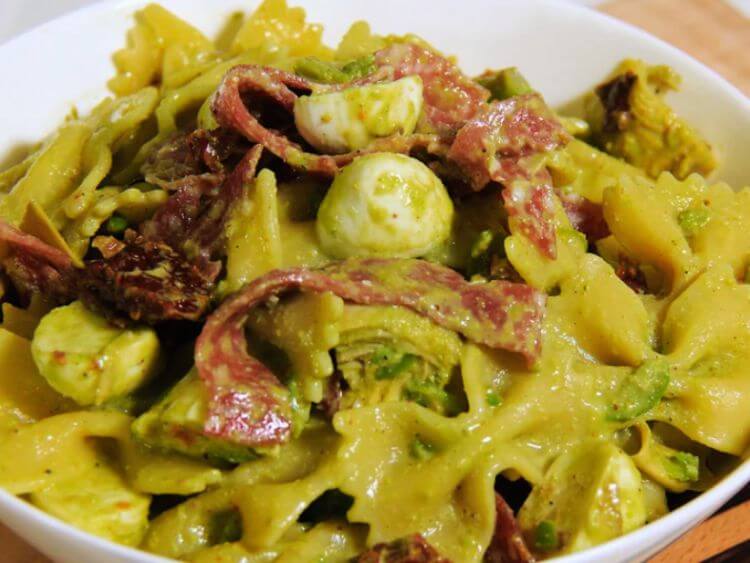Pasta salad, a beloved dish worldwide, epitomizes versatility and flavor. This delightful meal, often a staple at picnics, barbecues, and potlucks, offers a refreshing twist to traditional pasta dishes. Its popularity stems from its ability to blend various textures and tastes, creating a harmonious and satisfying eating experience. The beauty of pasta salad lies in its flexibility; it can be tailored to individual preferences or dietary needs, making it a universal favorite. From vibrant vegetables and zesty dressings to an array of pasta shapes, each ingredient plays a crucial role in crafting the perfect bowl. Ideal for both casual family dinners and large gatherings, pasta salad is not just a dish but a canvas for culinary creativity. Its ease of preparation and ability to be served cold or at room temperature adds to its appeal, making it a go-to choice for meals that require minimal fuss yet deliver maximum flavor.
Choosing the Right Pasta
Selecting the right pasta is a critical step in crafting a delightful pasta salad. The ideal pasta shapes are those that can hold onto dressings and accommodate the other ingredients in the salad. Short, sturdy pasta like fusilli, rotini, farfalle, and penne are excellent choices. Their ridges and curves are adept at trapping and holding onto the dressing, ensuring each bite is flavorful.
The size of the pasta also plays a significant role in the overall balance of the salad. Smaller pasta shapes, such as orzo or mini shells, are perfect for more delicate salads, where they complement rather than overpower the other ingredients. On the other hand, larger pasta shapes work well in heartier salads, filled with robust ingredients like chunky vegetables or meats.
Moreover, the surface texture of the pasta influences how well it absorbs and retains dressing. Pasta with a rougher surface texture tends to hold onto dressings better than those with a smooth surface. This is because the tiny grooves and ridges in the pasta provide more surface area for the dressing to cling to.
Cooking Pasta for Salad
Cooking pasta for salad requires a slightly different approach than for hot dishes. The ideal cooking time is crucial; pasta should be cooked just beyond al dente. This means boiling it for about one minute longer than the package’s instructions for al dente pasta. The reason for this is that pasta continues to firm up when cooled, so a slightly softer texture is needed to compensate for this hardening.
Salt plays a pivotal role in pasta water. It’s not just about seasoning; salt affects the pasta’s texture. Adding enough salt to the boiling water (it should taste as salty as seawater) ensures the pasta is flavored from the inside out, enhancing the overall taste of the salad. This step is particularly important since pasta salad dressings are often less intense than sauces used in hot pasta dishes.
Cooling and Rinsing Pasta
Once the pasta is cooked, stopping the cooking process immediately is essential to prevent it from becoming mushy. This is achieved by draining the pasta and then rinsing it under cold water. The cold water rinse serves two purposes: it cools the pasta quickly, halting the cooking process, and it washes away excess starch.
Excess starch on the surface of the pasta can make the salad gummy and cause the pasta to clump together. By rinsing, you ensure that each piece of pasta remains distinct and can evenly absorb the dressing. For the best texture in your pasta salad, spread the rinsed pasta on a baking sheet to cool it down rapidly and evenly. This technique also prevents the pasta from sticking together, ensuring that your salad will have the perfect consistency when mixed with the other ingredients.
Dressing Your Pasta Salad
Applying dressing to pasta salad is an art that balances timing and technique. The best practice is to dress the pasta while it’s still slightly warm. Warm pasta absorbs flavors more effectively, allowing the dressing to penetrate deeply and evenly. Begin by adding about two-thirds of the prepared dressing, tossing gently to ensure each piece of pasta is coated. This initial dressing not only flavors the pasta but also prevents it from sticking together as it cools.
Reserve the remaining dressing to add just before serving. This final addition revives the salad, enhancing its flavor and ensuring it’s moist and appetizing. It’s important to avoid overdressing; the pasta should be coated lightly and evenly, without pools of dressing at the bottom of the bowl. This balance ensures each bite is flavorful without being overwhelmed by the dressing.
Balancing Vinegar and Oil in Dressings
The harmony of vinegar and oil is crucial in pasta salad dressings. Choosing the right type of vinegar can make a significant difference. Milder vinegars like white wine, apple cider, or rice vinegar are often more suitable for pasta salads. They provide a subtle tang without overpowering the other flavors.
Oil, on the other hand, plays a dual role. It adds richness and helps to carry the flavors of the other dressing ingredients. A good quality extra-virgin olive oil is a popular choice, offering a depth of flavor that complements a variety of ingredients. The ratio of vinegar to oil is typically around one part vinegar to three parts oil, but this can be adjusted according to taste. The key is to achieve a balance where neither the acidity of the vinegar nor the richness of the oil dominates, creating a harmonious and flavorful dressing that enhances the pasta salad.
Related: What pasta is not recommended for pasta salads?, 4 Ingredient Pasta Salad, What pasta is not recommended for pasta salads?, What Are The Five Mistakes To Avoid Pasta Salad?, What Are The Five Mistakes To Avoid Pasta Salad?

